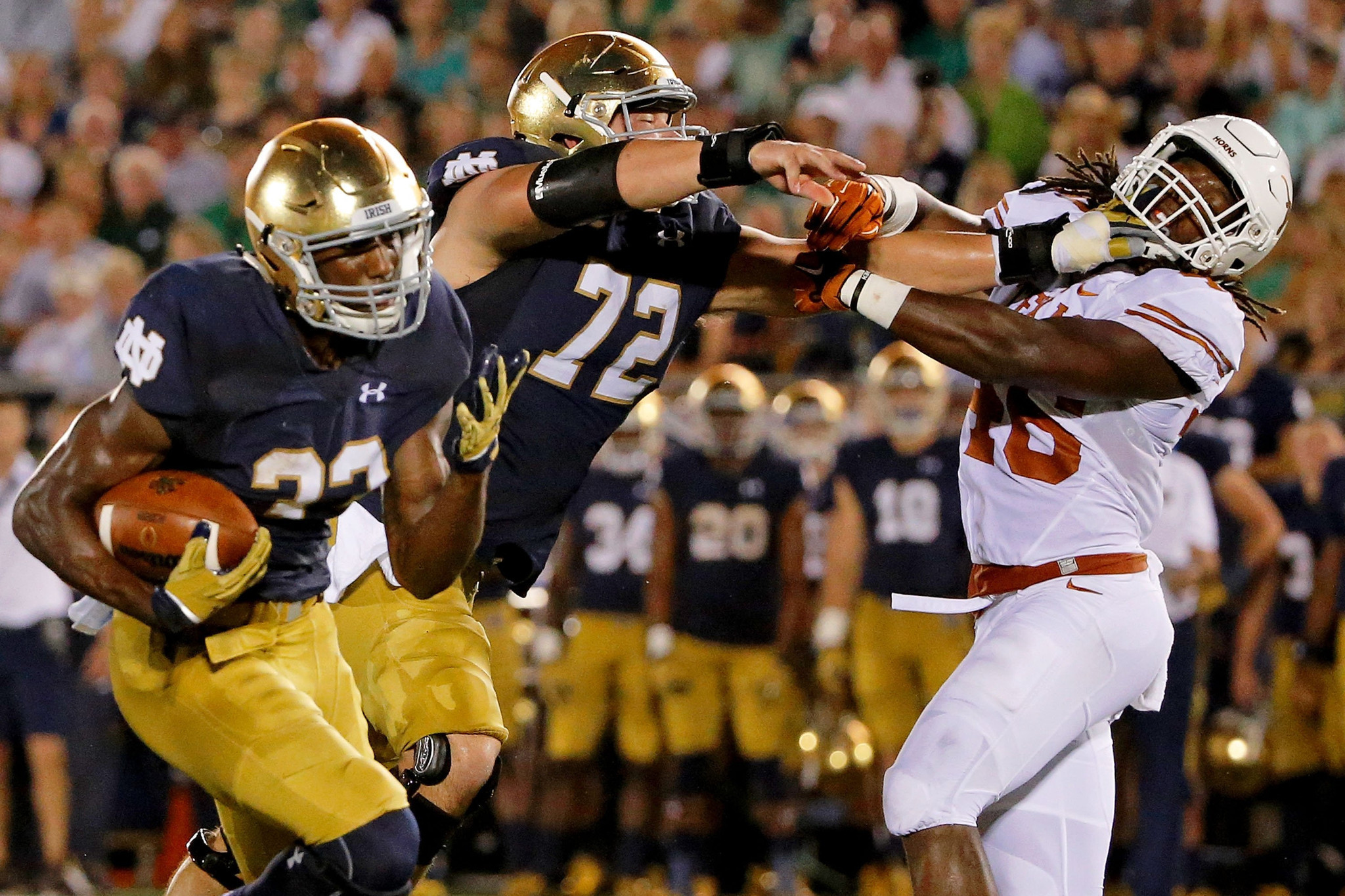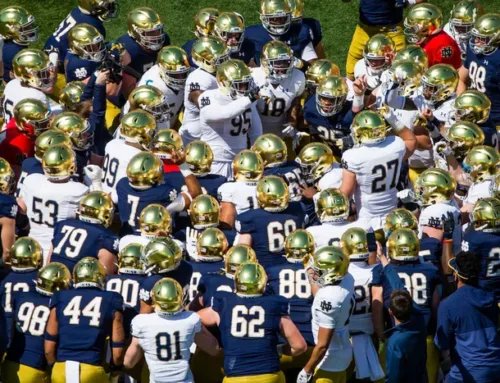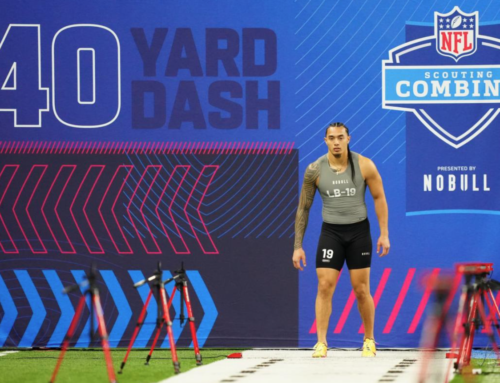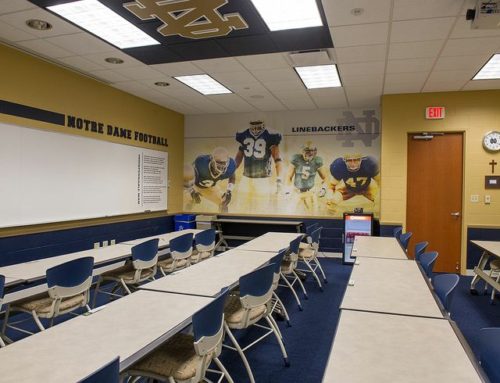Ah, it’s good to be back! Notre Dame football is now just 84 hours away, but who’s counting? Our advanced stats preview will give you everything you need to know before kickoff against Texas.
How do the numbers feel about the Irish’s chances in Austin? Where should Notre Dame have an advantage or be concerned? Are all of Texas’s stats from last year invalid since they have a new offensive system and quarterback (No, but it means we probably need to look at some of Tulsa’s numbers too). We’ll take a deep dive into all of these themes below (and plan to to continue for each game this season).
If looking for additional information on the stastistics and terms used here, great starting points are Football Studyhall’s Advanced Stats Glossary, Bill Connelly’s Five Factors, and Brian Fremeau’s FEI ratings.
Texas Offense vs. Notre Dame Defense:

If you’ve been within 10 miles of a Texas fan this offseason, you’ve heard it. “Our offense will be totally different next year! Fast, explosive, and with a new quarterback!” This is mostly true – the Longhorn offense should look far different next year under new coordinator Sterlin Gilbert. Texas ran a slow, run-first offense in 2015. This wasn’t a bad approach – the offensive line fared much better against the run than in pass protection, and passing the ball was a total struggle. Overall though, the Horns were maddeningly inconsistent and without much identity. Inconsistency is still a question, but as Burgs borke down in our film room, with Gilbert at the helm Texas does at least have an identity – play super-fast, spread ‘em out, and attack mismatches.
We know Gilbert’s vision of bringing a Baylor-like attack to Texas, but how well-equipped will the Longhorns be to implement in Week 1? Last year the Longhorns weren’t very explosive or efficient, but were most successful on the ground. The lack of efficiency in part was due to total inadequacy on passing downs, ranking near last in the county in success rate (24%, 199th). When they needed a pass and opponents knew it, whether after a few stops in the run game or a penalty, the Longhorns were screwed.
True freshman Shane Buechele figures to be the starter, although the fact that Charlie Strong hasn’t announced one yet could be construed either as a bad sign or gamesmanship forcing the Irish to prepare for multiple options. From Strong’s comments it sounds like old friend Tyrone Swoopes could play a few downs, but most insiders have pegged Buechele as the overwhelming favorite to receive the majority of snaps.
Whoever is back there will face a significant challenge, both playing their first game in a new system and lining up behind an offensive line that was bad in protection in 2015 and is currently beat up with three starters recovering from injury. There will be some opportunities though – with a young QB I expect Texas to lean early on good, experienced runners in D’Onta Foreman (7.2 yards per carry in 2015) and Chris Warren (6.6 YPC). If Notre Dame dares Buechele to throw, John Burt is an explosive target (16.3 yards per catch) for Devin Studstill and Drue Tranquill to keep an eye on.
3 Things to Watch:
1. Limiting bad esplosiva: If anything is getting Gilbert excited it’s that the Irish were ridiculously awful at giving up long touchdowns last season.. This was one of the Texas offense’s few strengths in 2015, and new playcaller and coordinator Sterlin Gilbert had an explosive offense at Tulsa last year (although adjusting for opponents does take their explosiveness rank from top-30 to around average nationally). Foreman and Warren are explosive runners in the open field, so if the Irish struggle with assignments or pace, watch out.
Any confidence I had about the Irish limiting explosive plays is currently postponed with a strong safety with coverage concerns and a true freshman rotating at free safety. Obvious counterpoint: both surely have better heads on their shoulders than the senior previously occupying that position, but I’m taking a “believe it when I see it” approach for now. Add in a high potential for trick plays with a versatile and dangerous threat in Jerrod Heard , and this is an enormous watch-out area.
2. Calling a pass rush? Last season Texas struggled mightily protecting the quarterback. You probably remember this, since they made a pretty mediocre ND defense look like the ’85 Bears in last year’s opener. The Horns finished 127th out of 128 teams in adjusted sack rate given up, and 128th in protecting the QB on passing downs.
Can the Notre Dame defense, sorely in need of effective edge rushing and disruption, take advantage? With a true freshman starting and an up-tempo offense, the focus for Gilbert’s first few play calls will be getting the ball out quickly. How will Buechele react if his first reads are covered?
Even if the Irish aren’t landing sacks, at a minimum the defensive line should be wreaking havoc in some form. Watch for hurries, batted passes, and some hits to welcome Buechele to NCAA Football. If the Irish defense can win the leverage game and force the guys in burnt orange into passing downs, they should be successful.
3. Tempo, tempo tempo: Playing fast can be a double edged sword. It can certainly be used to an offense’s advantage, but if you fail, you can also fail fast – and wear out your own defense instead of the opponents’. At Tulsa, Gilbert’s offense ranked 2nd in adjusted pace last season, and their run/pass splits were about average. In 2015 Texas was extremely run-heavy – 73% run rate on standard downs (11th highest in the country) and 51.1% (7th highest) on passing downs.
Time of possession is often misused as cause versus effect, but a better way to think of this is number of plays run by one team versus another. We can (and have) argued the merits of Brian Van Gorder’s scheme, but one piece of support in 2015 was a very high rate of three-and-outs. If anything three (or even six) and outs are underrated – not only do you get the ball back, you’re limiting the plays your defense faces and should be gaining key ground in another sneaky important area – field position.
Notre Dame Offense vs. Texas Defense

Defense is Charlie Strong’s calling-card, and Texas should have a pretty good one this season. There’s a ton of returning guys in the two-deep, most of whom were talented young guys forced into playing time a little too early. The Longhorns lost one key starter from each level – DT Hassan Ridgeway, LB and leading tackler Peter Jinkens, and CB Duke Thomas (last seen by most Irish fans chasing Will Fuller).
In 2015, the Longhorns didn’t give up many big plays, and were very solid against the pass. Run defense was an issue – even with one of the more experienced position groups on that side of the ball, the defensive line got pushed around. Texas was decent to nice in power run situations (69th nationally), but just 116th in stuff rate and 112th in opportunity rate. Adjusting for opponents didn’t help much, as they were still just 74th in adjusted line yards.
While Harry Hiestand and Josh Adams are probably licking their chops, the receiving corps has a big challenge in front of them with the Texas pass defense. The Horns were very good on passing downs in 2015, driven by a bend (122th in opponent success rate) but pretty much never break (6th in opponent IsoPPP on passing downs) approach. A strong pass rush, rated 16th in the country in adjusted sack rate, paired with good safety play to create strong pressure that didn’t open up vulnerability on the back end of the defense – so essentially the opposite of the 2015 Notre Dame defense.
3 Things to Watch:
1. Can Texas make the Irish pass? I fully expect Notre Dame to test the Longhorn defense early – seeing if strength of the offensive line can push around the home team like they did in South Bend last season. At what point will Texas start stacking the box and daring young receivers (and rotating quarterbacks) to beat them through the air?
Brian Kelly has shown to be a big proponent of taking what the defense gives them, and early on I’d expect the coaching chess match to focus on bodies near the line of scrimmage and how that impacts run/pass splits both teams want to see different things from. Leverage rate will be important here as well – can Notre Dame avoid dumb penalties and stuffed runs (the one area of rushing weakness last year) that force passing downs?
2. Scoring opportunities turning into touchdowns: Did you know that Notre Dame finished 35th last season in points per scoring opportunity? How about 7th in Red Zone S&P+? Probably not, and that’s because both are a little misleading – points per scoring opportunity includes possessions moving within an opponents’ 40 AND touchdowns scored from outside that area, so it’s boosted by lots of Will Fuller and Josh Adams explosions.
The numbers illustrated by Red Zone S&P+ highlight what the true problem has been for Brian Kelly’s offenses. It hasn’t been about moving the ball close to the goal line, but turning it over there. You’ll often see red zone scoring percentages and field goal percentages cited, but really the best measure of success in the scoring area is the points per possession. Coming away with zero points in these situations due to fumbles, interceptions, or holding issues on field goals (hello 2014 memories!) is an absolute killer.
So this year I’ll closely be tracking points per scoring opportunity (since drives inside the 40 is still valuable –this should be scoring range) and points per red zone possession. It’s worth noting that very few teams have been consistently successful at red zone scoring – Stanford struggled mightily in the post-Andrew Luck era before last season, Alabama has been mostly average despite mutant running backs and offensive linemen, and Ohio State has been inconsistent under Urban Meyer. It’s a complex problem to solve that extends far beyond play-calling, but an area where it’s reasonable to expect improvement in 2016.
3. How will the two quarterback rotation play out? No one has any idea exactly how Kizer and Zaire will share time – alternating series, one as a red zone quarterback, or a short yardage specialist? It will be interesting to see what we can find out for this game – how the offense runs with each behind center, how run/pass splits change (or doesn’t) depending on who is back there, and if Brian Kelly has opened up the NFL Blitz playbook for some two-QB formations.
Predictions:
FEI: Notre Dame 31, Texas 23
MB: I think both offenses will get off to slow starts, but the Irish find their rhythm in the 2nd half and hold off the Longhorns in a game that feels more painful than it should be. Notre Dame 38, Texas 24.





The closer to the game we get the more concerned I am about two things. First is the 2 qb doo-dah. I’m just not buying into it. In an already pressurised situation ( first game, under the lights, 100k crowd, away game), both guys have the added pressure of looking over their shoulder and not having time to get in rhythm. Whoever starts, if he moves the ball well, I’d like to see stay in. Period.
Second concern is Texas offensive speed. Those two big backs are very fast. Burt is very fast. One of the young Baylor guys who moved over is even faster (Clearwall knows him). Could be troubled times with our not so fast safeties and relatively inexperienced dbacks.
i think it will be a tough game, closer than many are expecting.
Totally agree that Texas’ skill players are a concern, the big question is if they can get the ball to them. Swoopes has thus far into his career shown an inability to be accurate to hit those fast receivers, and the O-Line hasn’t given them time to get separation. Blocking and throwing accuracy are huge question marks, and while ND’s pass rush hasn’t been fearsome, they won the battle up front handily last year and the Horns line, while a little older, is a little nicked up.
“1. Limiting bad esplosiva:” You can’t take the one beautiful, shining, glorious memory of 2015 and use it negatively! Cannot, Never, No! Nevernevernevernever…
That’s just my one nit. Otherwise, fabulous article, thanks!
Interesting, looks like TX O vs ND D will be a pretty even match up. We have the edge when our offense is on the field. None of this is surprising, but it’s just nice to see the numbers confirm it.
As unoriginal as it seems, based on the evidence above, the team that runs the ball better will win. I think we can limit their ground game, I’m not confident UT will be able to consistently slow us down. Aren’t they down to like 3 scholarship D-linemen? Lots of chop licking by our 0-line indeed.